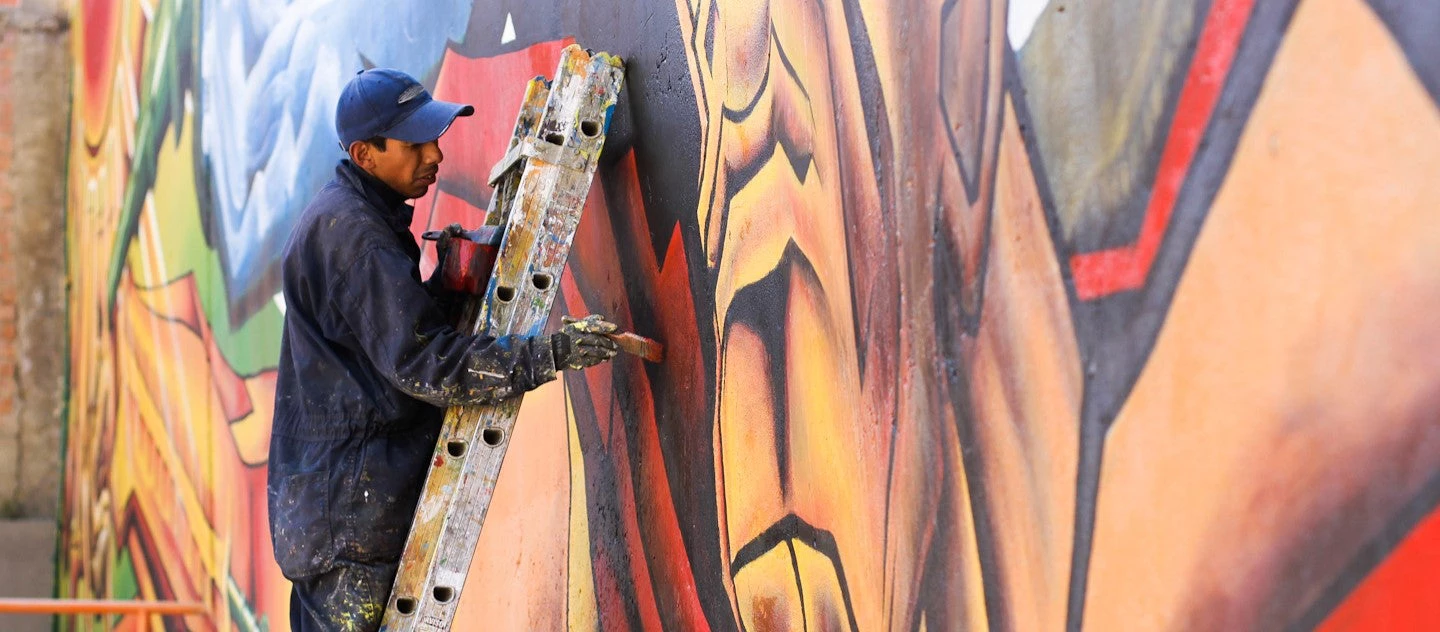 Pintor trabajando en un mural multicolor en la periferia urbana de La Paz, Bolivia.
Pintor trabajando en un mural multicolor en la periferia urbana de La Paz, Bolivia.
Thirty years ago, the world celebrated for the first time the International Day for the Eradication of Poverty on October 17th, 1993. Since then, we have faced periods of dizzying economic growth, followed by others of sharp deceleration including a pandemic that exposed humanity to an unexpected stress test and wreaking havoc on the global economy for over two years. It has been thirty years, more than enough time to carry out an evaluation of the efforts, especially in Latin America and the Caribbean, to fulfill the moral imperative of eradicating poverty and, especially, extreme poverty.
Meeting this objective is not easy, anywhere in the world. However, in Latin America and the Caribbean the challenge has distinctive features. This is a vast region, diverse and full of particularities. We are part of a region that continues to struggle to eradicate poverty, and trends across countries are dissimilar. Added to this are two additional problems: the persistently high levels of income inequality and the vulnerability to poverty of a large segment of the population.
The good news is that three years after the pandemic outbreak, the region managed to recover. Recent household survey data collected for 2022 indicates that the region has returned to the poverty levels recorded before the pandemic (26.7 percent. In fact, the recovery has been faster than initially predicted. To a large extent, this is explained by the strong pace at which the poverty rate fell in Mexico between 2020 and 2022 (from one-third to one-fourth of the population). Brazil also recorded better-than-expected performances, and due to its size, they have a notable influence on the region's aggregate figures. However, our poverty rates still are unacceptably high.
Factors behind poverty eradication
In Latin America and the Caribbean exists many factors that influence poverty eradication. Among them are the weakness of social protection systems and the deficiency in the provision of basic services such as health and education. The result is that a third of Latin American and Caribbean people are not poor, but they live one shock away from being brought back into poverty . It could be the loss of a job, a serious illness that affects any member of the family, a natural disaster or a macroeconomic crisis.
Undeniably, the region has registered important progress in the fight against poverty. In the aggregate, in Latin America and the Caribbean between 2000 and 2022, poverty measured with the upper-middle income country (UMIC) poverty line of USD 6.85 per day (2017 PPP) was reduced by 20 percentage points. Some countries, such as Peru, Colombia, Bolivia and El Salvador, had truly exceptional performances.
Colombia, for example, reduced its poverty rate by half from 67 percent between 2001 and 2017, before the pandemic . El Salvador went from 51 percent in 2000 to 27.5 percent in 2022, although it is striking that at the extreme poverty line (USD 2.15/day, 2017 PPP), the percentage of people has more than doubled since the pandemic .
Trends and projections of poverty, vulnerability and middle classes in Latin America and the Caribbean 2000-23e
In the fight against poverty, the region has had important victories, but we must be honest and recognize that most of these achievements occurred during the first decade of the new millennium. Significant social gains occurred between 2000 and 2012. It is in that period that the poverty rate was reduced from 50 to 30 percent but since then, poverty reduction has stagnated, only with minor variations. Then the pandemic exposed our acute vulnerability and sent millions of people below the poverty line. The poverty rate for Latin America and the Caribbean went from 28.3 percent in 2019 to 30.3 percent in 2021. This situation was especially dramatic in countries such as Peru – whose rate jumped from 28.9 percent in 2019 to 43 percent in 2020 –, Colombia – from 34.8 percent to 42.2 percent, in the same period– and Costa Rica –from 13.7 percent to 19.9 percent.
Poverty changes in Latin America and the Caribbean since 2019
By 2023, our projections indicate that the poverty rate will continue to reduce and reach 26.7 percent in 2022 and will reach 26 percent . To avoid hitting a wall we need to ask ourselves: why has it been so difficult to make sustained progress in reducing poverty in Latin America and the Caribbean? And what can be done to resume vigorous progress towards poverty eradication across the region? With the caveat that each country has its own particularities that need to be studied independently, it is important to emphasize that, as a region, we have much work to do in terms of generating and making the most of human capital.
For the medium and long term, we have to invest in more and better in education, in better services for the population and in social security/protection mechanisms that reduce vulnerabilit y. In the short term, it is urgent to ensure that our economies generate better jobs and mechanisms, such as the productive use of digital technologies, that facilitate access to labor markets for all people, without ethnic, gender or any other class distinctions. In short, we need to build better societies, more productive, but also more supportive and egalitarian. Only in this way can we advance more quickly in eradicating poverty. It is our mandate.
Stay updated with our weekly article
Realated article:




Join the Conversation